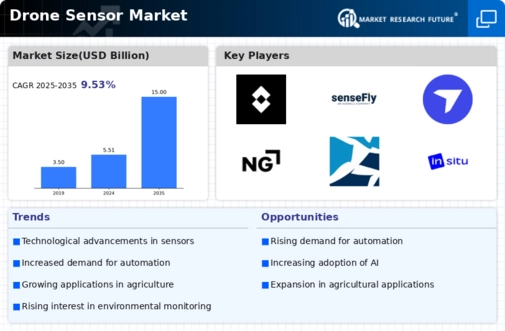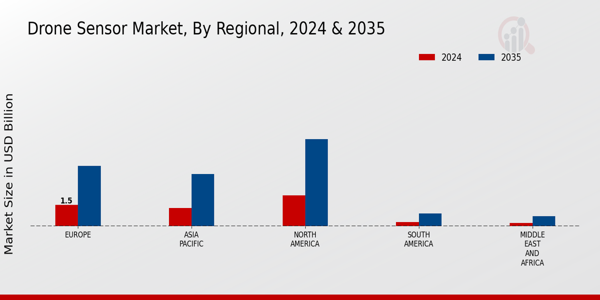Agriculture
Surveillance
Environmental Monitoring
Logistics
Infrastructure Inspection
Lidar
Camera
Thermal Sensors
Ultrasonic Sensors
Multi-Spectral Sensors
Government
Commercial
Defense
Research and Development
Fixed-Wing
Rotary-Wing
Hybrid
North America
Europe
South America
Asia Pacific
Middle East and Africa
North America Outlook (USD Billion, 2019-2035)
North America Drone Sensor Market by Application Type
Agriculture
Surveillance
Environmental Monitoring
Logistics
Infrastructure Inspection
North America Drone Sensor Market by Sensor Type
Lidar
Camera
Thermal Sensors
Ultrasonic Sensors
Multi-Spectral Sensors
North America Drone Sensor Market by End Use Type
Government
Commercial
Defense
Research and Development
North America Drone Sensor Market by Platform Type
Fixed-Wing
Rotary-Wing
Hybrid
North America Drone Sensor Market by Regional Type
US
Canada
US Outlook (USD Billion, 2019-2035)
US Drone Sensor Market by Application Type
Agriculture
Surveillance
Environmental Monitoring
Logistics
Infrastructure Inspection
US Drone Sensor Market by Sensor Type
Lidar
Camera
Thermal Sensors
Ultrasonic Sensors
Multi-Spectral Sensors
US Drone Sensor Market by End Use Type
Government
Commercial
Defense
Research and Development
US Drone Sensor Market by Platform Type
Fixed-Wing
Rotary-Wing
Hybrid
CANADA Outlook (USD Billion, 2019-2035)
CANADA Drone Sensor Market by Application Type
Agriculture
Surveillance
Environmental Monitoring
Logistics
Infrastructure Inspection
CANADA Drone Sensor Market by Sensor Type
Lidar
Camera
Thermal Sensors
Ultrasonic Sensors
Multi-Spectral Sensors
CANADA Drone Sensor Market by End Use Type
Government
Commercial
Defense
Research and Development
CANADA Drone Sensor Market by Platform Type
Fixed-Wing
Rotary-Wing
Hybrid
Europe Outlook (USD Billion, 2019-2035)
Europe Drone Sensor Market by Application Type
Agriculture
Surveillance
Environmental Monitoring
Logistics
Infrastructure Inspection
Europe Drone Sensor Market by Sensor Type
Lidar
Camera
Thermal Sensors
Ultrasonic Sensors
Multi-Spectral Sensors
Europe Drone Sensor Market by End Use Type
Government
Commercial
Defense
Research and Development
Europe Drone Sensor Market by Platform Type
Fixed-Wing
Rotary-Wing
Hybrid
Europe Drone Sensor Market by Regional Type
Germany
UK
France
Russia
Italy
Spain
Rest of Europe
GERMANY Outlook (USD Billion, 2019-2035)
GERMANY Drone Sensor Market by Application Type
Agriculture
Surveillance
Environmental Monitoring
Logistics
Infrastructure Inspection
GERMANY Drone Sensor Market by Sensor Type
Lidar
Camera
Thermal Sensors
Ultrasonic Sensors
Multi-Spectral Sensors
GERMANY Drone Sensor Market by End Use Type
Government
Commercial
Defense
Research and Development
GERMANY Drone Sensor Market by Platform Type
Fixed-Wing
Rotary-Wing
Hybrid
UK Outlook (USD Billion, 2019-2035)
UK Drone Sensor Market by Application Type
Agriculture
Surveillance
Environmental Monitoring
Logistics
Infrastructure Inspection
UK Drone Sensor Market by Sensor Type
Lidar
Camera
Thermal Sensors
Ultrasonic Sensors
Multi-Spectral Sensors
UK Drone Sensor Market by End Use Type
Government
Commercial
Defense
Research and Development
UK Drone Sensor Market by Platform Type
Fixed-Wing
Rotary-Wing
Hybrid
FRANCE Outlook (USD Billion, 2019-2035)
FRANCE Drone Sensor Market by Application Type
Agriculture
Surveillance
Environmental Monitoring
Logistics
Infrastructure Inspection
FRANCE Drone Sensor Market by Sensor Type
Lidar
Camera
Thermal Sensors
Ultrasonic Sensors
Multi-Spectral Sensors
FRANCE Drone Sensor Market by End Use Type
Government
Commercial
Defense
Research and Development
FRANCE Drone Sensor Market by Platform Type
Fixed-Wing
Rotary-Wing
Hybrid
RUSSIA Outlook (USD Billion, 2019-2035)
RUSSIA Drone Sensor Market by Application Type
Agriculture
Surveillance
Environmental Monitoring
Logistics
Infrastructure Inspection
RUSSIA Drone Sensor Market by Sensor Type
Lidar
Camera
Thermal Sensors
Ultrasonic Sensors
Multi-Spectral Sensors
RUSSIA Drone Sensor Market by End Use Type
Government
Commercial
Defense
Research and Development
RUSSIA Drone Sensor Market by Platform Type
Fixed-Wing
Rotary-Wing
Hybrid
ITALY Outlook (USD Billion, 2019-2035)
ITALY Drone Sensor Market by Application Type
Agriculture
Surveillance
Environmental Monitoring
Logistics
Infrastructure Inspection
ITALY Drone Sensor Market by Sensor Type
Lidar
Camera
Thermal Sensors
Ultrasonic Sensors
Multi-Spectral Sensors
ITALY Drone Sensor Market by End Use Type
Government
Commercial
Defense
Research and Development
ITALY Drone Sensor Market by Platform Type
Fixed-Wing
Rotary-Wing
Hybrid
SPAIN Outlook (USD Billion, 2019-2035)
SPAIN Drone Sensor Market by Application Type
Agriculture
Surveillance
Environmental Monitoring
Logistics
Infrastructure Inspection
SPAIN Drone Sensor Market by Sensor Type
Lidar
Camera
Thermal Sensors
Ultrasonic Sensors
Multi-Spectral Sensors
SPAIN Drone Sensor Market by End Use Type
Government
Commercial
Defense
Research and Development
SPAIN Drone Sensor Market by Platform Type
Fixed-Wing
Rotary-Wing
Hybrid
REST OF EUROPE Outlook (USD Billion, 2019-2035)
REST OF EUROPE Drone Sensor Market by Application Type
Agriculture
Surveillance
Environmental Monitoring
Logistics
Infrastructure Inspection
REST OF EUROPE Drone Sensor Market by Sensor Type
Lidar
Camera
Thermal Sensors
Ultrasonic Sensors
Multi-Spectral Sensors
REST OF EUROPE Drone Sensor Market by End Use Type
Government
Commercial
Defense
Research and Development
REST OF EUROPE Drone Sensor Market by Platform Type
Fixed-Wing
Rotary-Wing
Hybrid
APAC Outlook (USD Billion, 2019-2035)
APAC Drone Sensor Market by Application Type
Agriculture
Surveillance
Environmental Monitoring
Logistics
Infrastructure Inspection
APAC Drone Sensor Market by Sensor Type
Lidar
Camera
Thermal Sensors
Ultrasonic Sensors
Multi-Spectral Sensors
APAC Drone Sensor Market by End Use Type
Government
Commercial
Defense
Research and Development
APAC Drone Sensor Market by Platform Type
Fixed-Wing
Rotary-Wing
Hybrid
APAC Drone Sensor Market by Regional Type
China
India
Japan
South Korea
Malaysia
Thailand
Indonesia
Rest of APAC
CHINA Outlook (USD Billion, 2019-2035)
CHINA Drone Sensor Market by Application Type
Agriculture
Surveillance
Environmental Monitoring
Logistics
Infrastructure Inspection
CHINA Drone Sensor Market by Sensor Type
Lidar
Camera
Thermal Sensors
Ultrasonic Sensors
Multi-Spectral Sensors
CHINA Drone Sensor Market by End Use Type
Government
Commercial
Defense
Research and Development
CHINA Drone Sensor Market by Platform Type
Fixed-Wing
Rotary-Wing
Hybrid
INDIA Outlook (USD Billion, 2019-2035)
INDIA Drone Sensor Market by Application Type
Agriculture
Surveillance
Environmental Monitoring
Logistics
Infrastructure Inspection
INDIA Drone Sensor Market by Sensor Type
Lidar
Camera
Thermal Sensors
Ultrasonic Sensors
Multi-Spectral Sensors
INDIA Drone Sensor Market by End Use Type
Government
Commercial
Defense
Research and Development
INDIA Drone Sensor Market by Platform Type
Fixed-Wing
Rotary-Wing
Hybrid
JAPAN Outlook (USD Billion, 2019-2035)
JAPAN Drone Sensor Market by Application Type
Agriculture
Surveillance
Environmental Monitoring
Logistics
Infrastructure Inspection
JAPAN Drone Sensor Market by Sensor Type
Lidar
Camera
Thermal Sensors
Ultrasonic Sensors
Multi-Spectral Sensors
JAPAN Drone Sensor Market by End Use Type
Government
Commercial
Defense
Research and Development
JAPAN Drone Sensor Market by Platform Type
Fixed-Wing
Rotary-Wing
Hybrid
SOUTH KOREA Outlook (USD Billion, 2019-2035)
SOUTH KOREA Drone Sensor Market by Application Type
Agriculture
Surveillance
Environmental Monitoring
Logistics
Infrastructure Inspection
SOUTH KOREA Drone Sensor Market by Sensor Type
Lidar
Camera
Thermal Sensors
Ultrasonic Sensors
Multi-Spectral Sensors
SOUTH KOREA Drone Sensor Market by End Use Type
Government
Commercial
Defense
Research and Development
SOUTH KOREA Drone Sensor Market by Platform Type
Fixed-Wing
Rotary-Wing
Hybrid
MALAYSIA Outlook (USD Billion, 2019-2035)
MALAYSIA Drone Sensor Market by Application Type
Agriculture
Surveillance
Environmental Monitoring
Logistics
Infrastructure Inspection
MALAYSIA Drone Sensor Market by Sensor Type
Lidar
Camera
Thermal Sensors
Ultrasonic Sensors
Multi-Spectral Sensors
MALAYSIA Drone Sensor Market by End Use Type
Government
Commercial
Defense
Research and Development
MALAYSIA Drone Sensor Market by Platform Type
Fixed-Wing
Rotary-Wing
Hybrid
THAILAND Outlook (USD Billion, 2019-2035)
THAILAND Drone Sensor Market by Application Type
Agriculture
Surveillance
Environmental Monitoring
Logistics
Infrastructure Inspection
THAILAND Drone Sensor Market by Sensor Type
Lidar
Camera
Thermal Sensors
Ultrasonic Sensors
Multi-Spectral Sensors
THAILAND Drone Sensor Market by End Use Type
Government
Commercial
Defense
Research and Development
THAILAND Drone Sensor Market by Platform Type
Fixed-Wing
Rotary-Wing
Hybrid
INDONESIA Outlook (USD Billion, 2019-2035)
INDONESIA Drone Sensor Market by Application Type
Agriculture
Surveillance
Environmental Monitoring
Logistics
Infrastructure Inspection
INDONESIA Drone Sensor Market by Sensor Type
Lidar
Camera
Thermal Sensors
Ultrasonic Sensors
Multi-Spectral Sensors
INDONESIA Drone Sensor Market by End Use Type
Government
Commercial
Defense
Research and Development
INDONESIA Drone Sensor Market by Platform Type
Fixed-Wing
Rotary-Wing
Hybrid
REST OF APAC Outlook (USD Billion, 2019-2035)
REST OF APAC Drone Sensor Market by Application Type
Agriculture
Surveillance
Environmental Monitoring
Logistics
Infrastructure Inspection
REST OF APAC Drone Sensor Market by Sensor Type
Lidar
Camera
Thermal Sensors
Ultrasonic Sensors
Multi-Spectral Sensors
REST OF APAC Drone Sensor Market by End Use Type
Government
Commercial
Defense
Research and Development
REST OF APAC Drone Sensor Market by Platform Type
Fixed-Wing
Rotary-Wing
Hybrid
South America Outlook (USD Billion, 2019-2035)
South America Drone Sensor Market by Application Type
Agriculture
Surveillance
Environmental Monitoring
Logistics
Infrastructure Inspection
South America Drone Sensor Market by Sensor Type
Lidar
Camera
Thermal Sensors
Ultrasonic Sensors
Multi-Spectral Sensors
South America Drone Sensor Market by End Use Type
Government
Commercial
Defense
Research and Development
South America Drone Sensor Market by Platform Type
Fixed-Wing
Rotary-Wing
Hybrid
South America Drone Sensor Market by Regional Type
Brazil
Mexico
Argentina
Rest of South America
BRAZIL Outlook (USD Billion, 2019-2035)
BRAZIL Drone Sensor Market by Application Type
Agriculture
Surveillance
Environmental Monitoring
Logistics
Infrastructure Inspection
BRAZIL Drone Sensor Market by Sensor Type
Lidar
Camera
Thermal Sensors
Ultrasonic Sensors
Multi-Spectral Sensors
BRAZIL Drone Sensor Market by End Use Type
Government
Commercial
Defense
Research and Development
BRAZIL Drone Sensor Market by Platform Type
Fixed-Wing
Rotary-Wing
Hybrid
MEXICO Outlook (USD Billion, 2019-2035)
MEXICO Drone Sensor Market by Application Type
Agriculture
Surveillance
Environmental Monitoring
Logistics
Infrastructure Inspection
MEXICO Drone Sensor Market by Sensor Type
Lidar
Camera
Thermal Sensors
Ultrasonic Sensors
Multi-Spectral Sensors
MEXICO Drone Sensor Market by End Use Type
Government
Commercial
Defense
Research and Development
MEXICO Drone Sensor Market by Platform Type
Fixed-Wing
Rotary-Wing
Hybrid
ARGENTINA Outlook (USD Billion, 2019-2035)
ARGENTINA Drone Sensor Market by Application Type
Agriculture
Surveillance
Environmental Monitoring
Logistics
Infrastructure Inspection
ARGENTINA Drone Sensor Market by Sensor Type
Lidar
Camera
Thermal Sensors
Ultrasonic Sensors
Multi-Spectral Sensors
ARGENTINA Drone Sensor Market by End Use Type
Government
Commercial
Defense
Research and Development
ARGENTINA Drone Sensor Market by Platform Type
Fixed-Wing
Rotary-Wing
Hybrid
REST OF SOUTH AMERICA Outlook (USD Billion, 2019-2035)
REST OF SOUTH AMERICA Drone Sensor Market by Application Type
Agriculture
Surveillance
Environmental Monitoring
Logistics
Infrastructure Inspection
REST OF SOUTH AMERICA Drone Sensor Market by Sensor Type
Lidar
Camera
Thermal Sensors
Ultrasonic Sensors
Multi-Spectral Sensors
REST OF SOUTH AMERICA Drone Sensor Market by End Use Type
Government
Commercial
Defense
Research and Development
REST OF SOUTH AMERICA Drone Sensor Market by Platform Type
Fixed-Wing
Rotary-Wing
Hybrid
MEA Outlook (USD Billion, 2019-2035)
MEA Drone Sensor Market by Application Type
Agriculture
Surveillance
Environmental Monitoring
Logistics
Infrastructure Inspection
MEA Drone Sensor Market by Sensor Type
Lidar
Camera
Thermal Sensors
Ultrasonic Sensors
Multi-Spectral Sensors
MEA Drone Sensor Market by End Use Type
Government
Commercial
Defense
Research and Development
MEA Drone Sensor Market by Platform Type
Fixed-Wing
Rotary-Wing
Hybrid
MEA Drone Sensor Market by Regional Type
GCC Countries
South Africa
Rest of MEA
GCC COUNTRIES Outlook (USD Billion, 2019-2035)
GCC COUNTRIES Drone Sensor Market by Application Type
Agriculture
Surveillance
Environmental Monitoring
Logistics
Infrastructure Inspection
GCC COUNTRIES Drone Sensor Market by Sensor Type
Lidar
Camera
Thermal Sensors
Ultrasonic Sensors
Multi-Spectral Sensors
GCC COUNTRIES Drone Sensor Market by End Use Type
Government
Commercial
Defense
Research and Development
GCC COUNTRIES Drone Sensor Market by Platform Type
Fixed-Wing
Rotary-Wing
Hybrid
SOUTH AFRICA Outlook (USD Billion, 2019-2035)
SOUTH AFRICA Drone Sensor Market by Application Type
Agriculture
Surveillance
Environmental Monitoring
Logistics
Infrastructure Inspection
SOUTH AFRICA Drone Sensor Market by Sensor Type
Lidar
Camera
Thermal Sensors
Ultrasonic Sensors
Multi-Spectral Sensors
SOUTH AFRICA Drone Sensor Market by End Use Type
Government
Commercial
Defense
Research and Development
SOUTH AFRICA Drone Sensor Market by Platform Type
Fixed-Wing
Rotary-Wing
Hybrid
REST OF MEA Outlook (USD Billion, 2019-2035)
REST OF MEA Drone Sensor Market by Application Type
Agriculture
Surveillance
Environmental Monitoring
Logistics
Infrastructure Inspection
REST OF MEA Drone Sensor Market by Sensor Type
Lidar
Camera
Thermal Sensors
Ultrasonic Sensors
Multi-Spectral Sensors
REST OF MEA Drone Sensor Market by End Use Type
Government
Commercial
Defense
Research and Development
REST OF MEA Drone Sensor Market by Platform Type
Fixed-Wing
Rotary-Wing
Hybrid













Leave a Comment